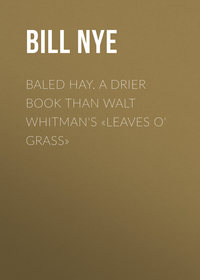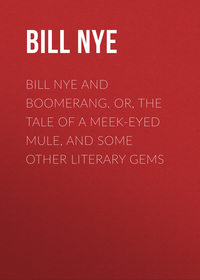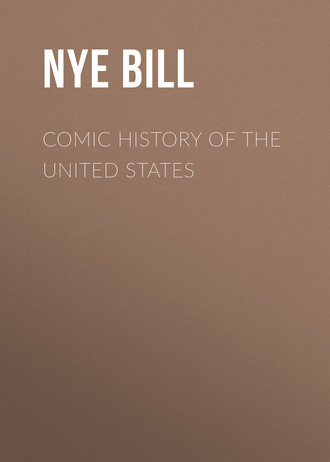 полная версия
полная версияComic History of the United States

Bill Nye
Comic History of the United States
PREFACE
Facts in a nude state are not liable criminally, any more than bright and beautiful children commit a felony by being born thus; but it is the solemn duty of those having these children in charge to put appropriate, healthful, and even attractive apparel upon them at the earliest possible moment.
It is thus with facts. They are the frame-work of history, not the drapery. They are like the cold, hard, dishevelled, damp, and uncomfortable body under the knife of the demonstrator, not the bright and bounding boy, clothed in graceful garments and filled to every tingling capillary with a soul.
We, each of us, the artist and the author, respect facts. We have never, either of us, said an unkind word regarding facts. But we believe that they should not be placed before the public exactly as they were born. We want to see them embellished and beautified. That is why this history is written.
Certain facts have come into the possession of the artist and author of this book regarding the history of the Republic down to the present day. We find, upon looking over the records and documents on file in the various archives of state and nation, that they are absolutely beyond question, and it is our object to give these truthfully. These rough and untidy, but impregnable truths, dressed in the sweet persuasive language of the author, and fluted, embossed, embroidered, and embellished by the skilful hand of the artist, are now before you.
History is but the record of the public and official acts of human beings. It is our object, therefore, to humanize our history and deal with people past and present; people who ate and possibly drank; people who were born, flourished, and died; not grave tragedians, posing perpetually for their photographs.
If we succeed in this way, and administer historical truth in the smooth capsule of the cartoonist and the commentator, we are content. If not, we know whose fault it will be, but will not get mad and swear about it.
Bill Nye.Fred'k B. Opper.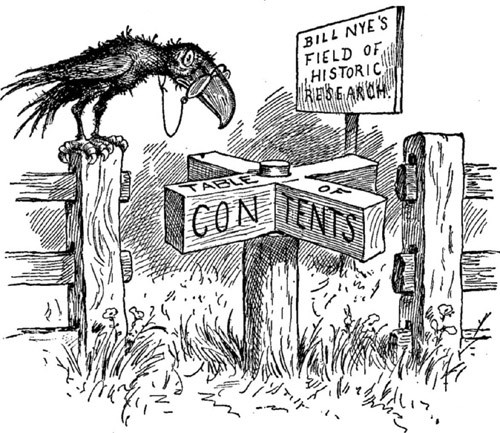
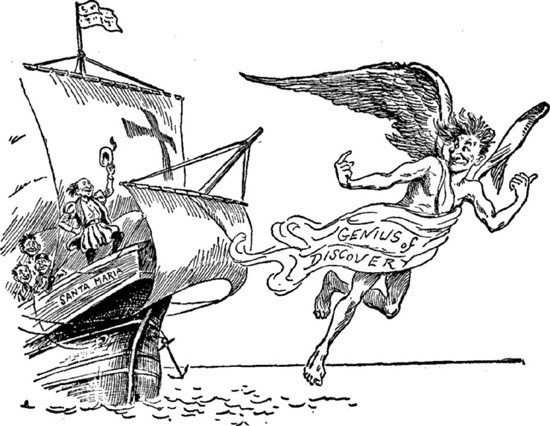
CHAPTER I.
THE DISCOVERY OF AMERICA
It was a beautiful evening at the close of a warm, luscious day in old Spain. It was such an evening as one would select for trysting purposes. The honeysuckle gave out the sweet announcement of its arrival on the summer breeze, and the bulbul sang in the dark vistas of olive-trees,—sang of his love and his hope, and of the victory he anticipated in the morrow's bulbul-fight, and the plaudits of the royal couple who would be there. The pink west paled away to the touch of twilight, and the soft zenith was sown with stars coming like celestial fire-flies on the breast of a mighty meadow.
Across the dusk, with bowed head, came a woman. Her air was one of proud humility. It was the air of royalty in the presence of an overruling power. It was Isabella. She was on her way to confession. She carried a large, beautifully-bound volume containing a memorandum of her sins for the day. Ever and anon she would refer to it, but the twilight had come on so fast that she could not read it.
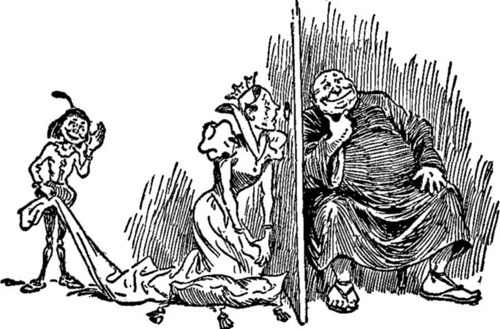
ISABELLA AT CONFESSIONAL.
Reaching the confessional, she kneeled, and, by the aid of her notes, she told off to the good Father and receptacle of the queen's trifling sins, Fernando de Talavera, how wicked she had been. When it was over and the queen had risen to go, Fernando came forth, and with a solemn obeisance said,—
"May it please your Majesty, I have to-day received a letter from my good friend the prior of the Franciscan convent of St. Mary's of Rabida in Andalusia. With your Majesty's permission, I will read it to you."
"Proceed," exclaimed Isabella, gravely, taking a piece of crochet-work from her apron and seating herself comfortably near the dim light.
"It is dated the sixth month and tenth day of the month, and reads as follows:
"Dear Brother:
"This letter will be conveyed unto your hands by the bearer hereof. His name is Christopher Columbus, a native of Genoa, who has been living on me for two years. But he is a good man, devout and honest. He is willing to work, but I have nothing to do in his line. Times, as you know, are dull, and in his own profession nothing seems to be doing.
"He is by profession a discoverer. He has been successful in the work where he has had opportunities, and there has been no complaint so far on the part of those who have employed him. Everything he has ever discovered has remained that way, so he is willing to let his work show for itself.
"Should you be able to bring this to the notice of her Majesty, who is tender of heart, I would be most glad; and should her most gracious Majesty have any discovering to be done, or should she contemplate a change or desire to substitute another in the place of the present discoverer, she will do well to consider the qualifications of my friend.
"Very sincerely and fraternally thine,"Etc., etc."The queen inquired still further regarding Columbus, and, taking the letter, asked Talavera to send him to the royal sitting-room at ten o'clock the following day.
When Columbus arose the next morning he found a note from the royal confessor, and, without waiting for breakfast, for he had almost overcome the habit of eating, he reversed his cuffs, and, taking a fresh handkerchief from his valise and putting it in his pocket so that the corners would coyly stick out a little, he was soon on his way to the palace. He carried also a small globe wrapped up in a newspaper.
The interview was encouraging until the matter of money necessary for the trip was touched upon. His Majesty was called in, and spoke sadly of the public surplus. He said that there were one hundred dollars still due on his own salary, and the palace had not been painted for eight years. He had taken orders on the store till he was tired of it. "Our meat bill," said he, taking off his crown and mashing a hornet on the wall, "is sixty days overdue. We owe the hired girl for three weeks; and how are we going to get funds enough to do any discovering, when you remember that we have got to pay for an extra session this fall for the purpose of making money plenty?"
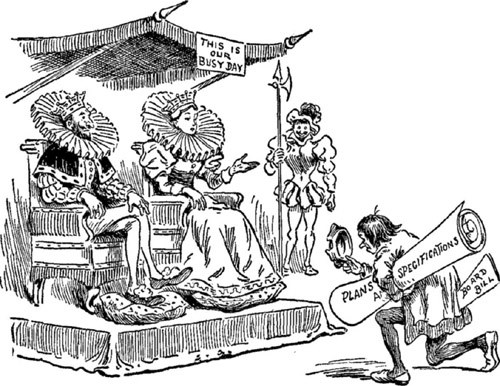
COLUMBUS AT COURT.
But Isabella came and sat by him in her winning way, and with the moistened corner of her handkerchief removed a spot of maple syrup from the ermine trimming of his reigning gown. She patted his hand, and, with her gentle voice, cheered him and told him that if he would economize and go without cigars or wine, in less than two hundred years he would have saved enough to fit Columbus out.
A few weeks later he had saved one hundred and fifty dollars in this way. The queen then went at twilight and pawned a large breastpin, and, although her chest was very sensitive to cold, she went without it all the following winter, in order that Columbus might discover America before immigration set in here.
Too much cannot be said of the heroism of Queen Isabella and the courage of her convictions. A man would have said, under such circumstances, that there would be no sense in discovering a place that was not popular. Why discover a place when it is so far out of the way? Why discover a country with no improvements? Why discover a country that is so far from the railroad? Why discover, at great expense, an entirely new country?
But Isabella did not stop to listen to these croaks. In the language of the Honorable Jeremiah M. Rusk, "She seen her duty and she done it." That was Isabella's style.
Columbus now began to select steamer-chairs and rugs. He had already secured the Niña, Pinta, and Santa Maria, and on the 3d of August, 1492, he sailed from Palos.
Isabella brought him a large bunch of beautiful flowers as he was about to sail, and Ferdinand gave him a nice yachting-cap and a spicy French novel to read on the road.
He was given a commission as viceroy or governor of all the lands he might discover, with hunting and shooting privileges on same.
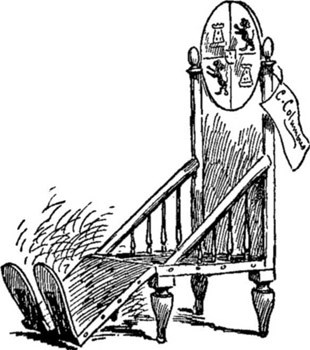
COLUMBUS'S STEAMER-CHAIR.
He stopped several weeks at the Canary Islands, where he and his one hundred and twenty men rested and got fresh water. He then set out sailing due west over an unknown sea to blaze the way for liberty.
Soon, however, his men began to murmur. They began also to pick on Columbus and occupy his steamer-chair when he wanted to use it himself. They got to making chalk-marks on the deck and compelling him to pay a shilling before he could cross them. Some claimed that they were lost and that they had been sailing around for over a week in a circle, one man stating that he recognized a spot in the sea that they had passed eight times already.
Finally they mutinied, and started to throw the great navigator overboard, but he told them that if they would wait until the next morning he would tell them a highly amusing story that he heard just before he left Palos.
Thus his life was saved, for early in the morning the cry of "Land ho!" was heard, and America was discovered.
A saloon was at once started, and the first step thus taken towards the foundation of a republic. From that one little timid saloon, with its family entrance, has sprung the magnificent and majestic machine which, lubricated with spoils and driven by wind, gives to every American to-day the right to live under a Government selected for him by men who make that their business.
Columbus discovered America several times after the 12th of October, 1492, and finally, while prowling about looking for more islands, discovered South America near the mouth of the Orinoco.
He was succeeded as governor by Francisco de Bobadilla, who sent him back finally in chains. Thus we see that the great are not always happy. There is no doubt that millions of people every year avoid many discomforts by remaining in obscurity.
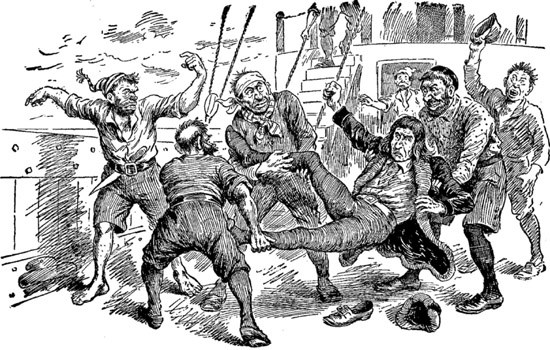
COLUMBUS HAVING TROUBLE WITH HIS SAILORS.
The life of Columbus has been written by hundreds of men, both in this country and abroad, but the foregoing facts are distilled from this great biographical mass by skilful hands, and, like the succeeding pages, will stand for centuries unshaken by the bombardment of the critic, while succeeding years shall try them with frost and thaw, and the tide of time dash high against their massive front, only to recede, quelled and defeated.1
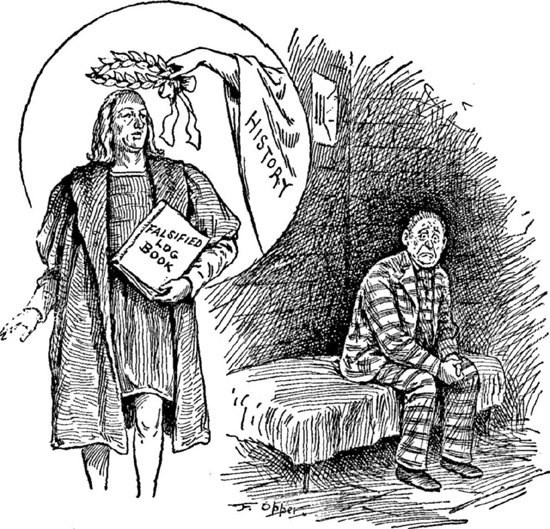
CHAPTER II.
OTHER DISCOVERIES—WET AND DRY
America had many other discoverers besides Columbus, but he seems to have made more satisfactory arrangements with the historians than any of the others. He had genius, and was also a married man. He was a good after-dinner speaker, and was first to use the egg trick, which so many after-dinner speakers have since wished they had thought of before Chris did.
In falsifying the log-book in order to make his sailors believe that they had not sailed so far as they had, Columbus did a wrong act, unworthy of his high notions regarding the pious discovery of this land. The artist has shown here not only one of the most faithful portraits of Columbus and his crooked log-book, but the punishment which he should have received.
The man on the left is Columbus; History is concealed just around the corner in a loose wrapper.
Spain at this time regarded the new land as a vast jewelry store in charge of simple children of the forest who did not know the value of their rich agricultural lands or gold-ribbed farms. Spain, therefore, expected to exchange bone collar-buttons with the children of the forest for opals as large as lima beans, and to trade fiery liquids to them for large gold bricks.
The Montezumas were compelled every little while to pay a freight-bill for the Spanish confidence man.
Ponce de Leon had started out in search of the Hot Springs of Arkansas, and in 1512 came in sight of Florida. He was not successful in his attempt to find the Fountain of Youth, and returned an old man so deaf that in the language of the Hoosier poet referring to his grandfather,—
"So remarkably deaf was my grandfather SqueersThat he had to wear lightning-rods over his earsTo even hear thunder, and oftentimes thenHe was forced to request it to thunder again."Balboa crossed the Isthmus of Darien, and, rolling up his pantalettes, waded into the Pacific Ocean and discovered it in the name of Spain. It was one of the largest and wettest discoveries ever made, and, though this occurred over three centuries ago, Spain is still poor.
Balboa, in discovering the Pacific, did so according to the Spanish custom of discovery, viz., by wading into it with his naked sword in one hand and the banner of Castile, sometimes called Castile's hope (see Appendix), in the other. He and his followers waded out so as to discover all they could, and were surprised to discover what is now called the undertow.
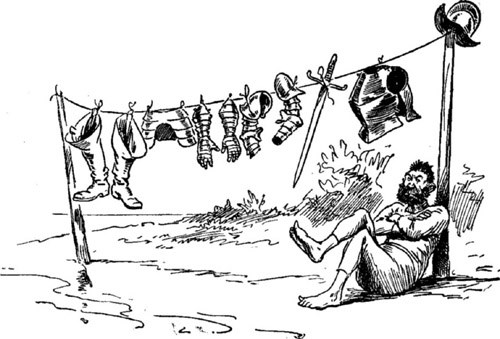
BALBOA DRYING HIS CLOTHES.
The artist has shown the great discoverer most truthfully as he appeared after he had discovered and filed on the ocean. No one can look upon this picture for a moment and confuse Balboa, the discoverer of the Pacific, with Kope Elias, who first discovered in the mountains of North Carolina what is now known as moonshine whiskey.
De Narvaez in 1528 undertook to conquer Florida with three hundred hands. He also pulled considerable grass in his search for gold. Finally he got to the gulf and was wrecked. They were all related mostly to Narvaez, and for two weeks they lived on their relatives, but later struck shore—four of them—and lived more on a vegetable diet after that till they struck the Pacific Ocean, which now belonged to Spain.
De Soto also undertook the conquest of Florida after this, and took six hundred men with him for the purpose. They wandered through the Gulf States to the Mississippi, enduring much, and often forced to occupy the same room at night. De Soto in 1541 discovered the Mississippi River, thus adding to the moisture collection of Spain.
After trying to mortgage his discovery to Eastern capitalists, he died, and was buried in the quiet bosom of the Great Father of waters.
Thus once more the list of fatalities was added to and the hunger for gold was made to contribute a discovery.
Menendez later on founded in 1565 the colony of St. Augustine, the oldest town in the United States. There are other towns that look older, but it is on account of dissipation. New York looks older, but it is because she always sat up later of nights than St. Augustine did.
Cortez was one of the coarsest men who visited this country. He did not marry any wealthy American girls, for there were none, but he did everything else that was wrong, and his unpaid laundry-bills are still found all over the Spanish-speaking countries. He was especially lawless and cruel to the Peruvians: "recognizing the Peruvian at once by his bark," he would treat him with great indignity, instead of using other things which he had with him. Cortez had a way of capturing the most popular man in a city, and then he would call on the tax-payers to redeem him on the instalment plan. Most everybody hated Cortez, and when he held religious services the neighbors did not attend. The religious efforts made by Cortez were not successful. He killed a great many people, but converted but few.
The historian desires at this time to speak briefly of the methods of Cortez from a commercial stand-point.
Will the reader be good enough to cast his eye on the Cortez securities as shown in the picture drawn from memory by an artist yet a perfect gentleman?
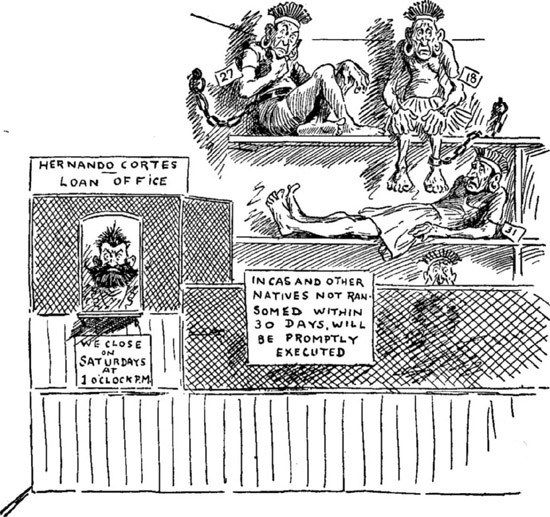
BANK OF CORTEZ.
Notice the bonds Nos. 18 and 27. Do you notice the listening attitude of No. 18? He is listening to the accumulating interest. Note the aged and haggard look of No. 27. He has just begun to notice that he is maturing.
Cast your eye on the prone form of No. 31. He has just fallen due, and in doing so has hurt his crazy-bone (see Appendix).
Be good enough to study the gold-bearing bond behind the screen. See the look of anguish. Some one has cut off a coupon probably. Cortez was that kind of a man. He would clip the ear of an Inca and make him scream with pain, so that his friends would come in and redeem him. Once the bank examiner came to examine the Cortez bank. He imparted a pleasing flavor on the following day to the soup.
Spain owned at the close of the sixteenth century the West Indies, Yucatan, Mexico, and Florida, besides unlimited water facilities and the Peruvian preserves.
North Carolina was discovered by the French navigator Verrazani, thirty years later than Cabot did, but as Cabot did not record his claim at the court-house in Wilmington the Frenchman jumped the claim in 1524, and the property remained about the same till again discovered by George W. Vanderbilt in the latter part of the present century.
Montreal was discovered in 1535 by Cartier, also a Frenchman.
Ribaut discovered South Carolina, and left thirty men to hold it. They were at that time the only white men from-Mexico to the North Pole, and a keen business man could have bought the whole thing, Indians and all, for a good team and a jug of nepenthe. But why repine?

CONVERTING INDIANS.
The Jesuit missionaries about the middle of the seventeenth century pushed their way to the North Mississippi and sought to convert the Indians. The Jesuits deserve great credit for their patience, endurance, and industry, but they were shocked to find the Indian averse to work. They also advanced slowly in church work, and would often avoid early mass that they might catch a mess of trout or violate the game law by killing a Dakotah in May.
Father Marquette discovered the Upper Mississippi not far from a large piece of suburban property owned by the author, north of Minneapolis. The ground has not been disturbed since discovered by Father Marquette.
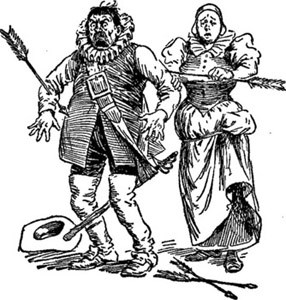
COULD NOT REACH THEM.
The English also discovered America from time to time, the Cabots finding Labrador while endeavoring to go to Asia via the North, and Frobisher discovered Baffin Bay in 1576 while on a like mission. The Spanish discovered the water mostly, and England the ice belonging to North America.
Sir Francis Drake also discovered the Pacific Ocean, and afterward sailed an English ship on its waters, discovering Oregon.
Sir Walter Raleigh, with the endorsement of his half-brother, Sir Humphrey Gilbert, regarding the idea of colonization of America, and being a great friend of Queen Elizabeth, got out a patent on Virginia.
He planted a colony and a patch of tobacco on Roanoke Island, but the colonists did not care for agriculture, preferring to hunt for gold and pearls. In this way they soon ran out of food, and were constantly harassed by Indians.
It was an odd sight to witness a colonist coming home after a long hard day hunting for pearls as he asked his wife if she would be good enough to pull an arrow out of some place which he could not reach himself.
Raleigh spent two hundred thousand dollars in his efforts to colonize Virginia, and then, disgusted, divided up his patent and sold county rights to it at a pound apiece. This was in 1589. Raleigh learned the use of smoking tobacco at this time.
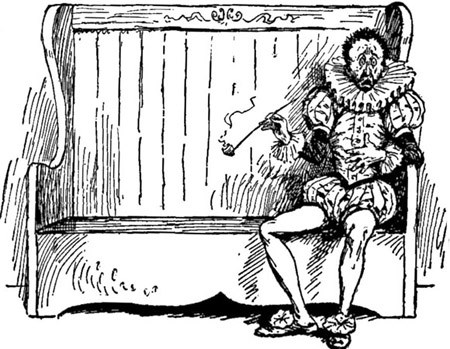
RALEIGH'S ASTONISHMENT.
He was astonished when he tried it first, and threatened to change his boarding-place or take his meals out, but soon enjoyed it, and before he had been home a week Queen Elizabeth thought it to be an excellent thing for her house plants. It is now extensively used in the best narcotic circles.

RALEIGH'S ENJOYMENT.
Several other efforts were made by the English to establish colonies in this country, but the Indians thought that these English people bathed too much, and invited perspiration between baths.
One can see readily that the Englishman with his portable bath-tub has been a flag of defiance from the earliest discoveries till this day.
This chapter brings us to the time when settlements were made as follows:

The author's thanks are due to the following books of reference, which, added to his retentive memory, have made the foregoing statements accurate yet pleasing:
A Summer in England with H. W. Beecher. By J. B. Reed.
Russell's Digest of the Laws of Minnesota, with Price-List of Members.
Out-Door and Bug Life in America. By Chilblainy, Chief of the Umatilla.
Why I am an Indian. By S. Bull. With Notes by Ole Bull and Introduction by John Bull.
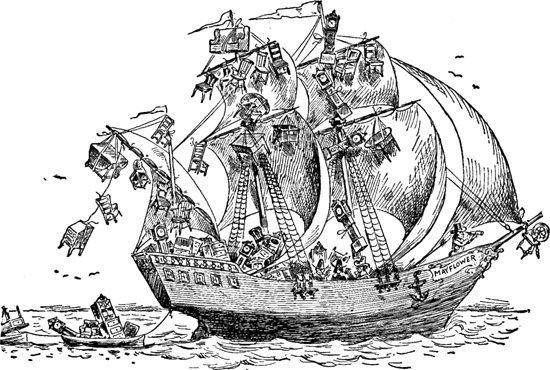
BONA FIDE PICTURE OF THE MAYFLOWER.
CHAPTER III.
THE THIRTEEN ORIGINAL COLONIES
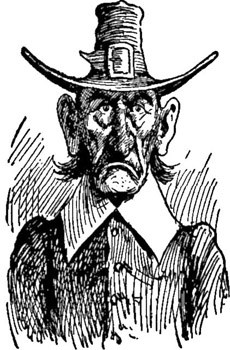
SAMPLE PURITAN.
This chapter is given up almost wholly to facts. It deals largely with the beginning of the thirteen original colonies from which sprang the Republic, the operation of which now gives so many thousands of men in-door employment four years at a time, thus relieving the penitentiaries and throwing more kindergarten statesmen to the front.
It was during this epoch that the Cavaliers landed in Virginia and the Puritans in Massachusetts; the latter lived on maple sugar and armed prayer, while the former saluted his cow, and, with bared head, milked her with his hat in one hand and his life in the other.
Immigration now began to increase along the coast. The Mayflower began to bring over vast quantities of antique furniture, mostly hall-clocks for future sales. Hanging them on spars and masts during rough weather easily accounts for the fact that none of them have ever been known to go.
The Puritans now began to barter with the Indians, swapping square black bottles of liquid hell for farms in Massachusetts and additions to log towns. Dried apples and schools began to make their appearance. The low retreating forehead of the codfish began to be seen at the stores, and virtue began to break out among the Indians after death.
Virginia, however, deserves mention here on the start. This colony was poorly prepared to tote wood and sleep out-of-doors, as the people were all gents by birth. They had no families, but came to Virginia to obtain fortunes and return to the city of New York in September. The climate was unhealthy, and before the first autumn, says Sir William Kronk, from whom I quote, "ye greater numberr of them hade perished of a great Miserrie in the Side and for lacke of Food, for at thatte time the Crosse betweene the wilde hyena and the common hogge of the Holy Lande, and since called the Razor Backe Hogge, had not been made, and so many of the courtiers dyede."
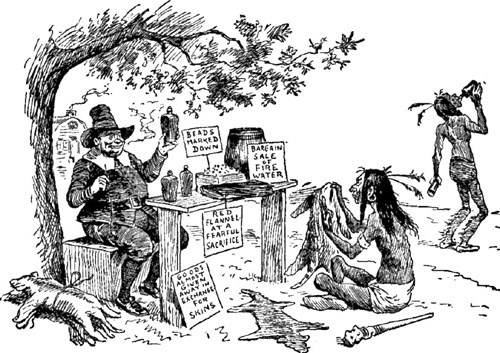
John Smith saved the colony. He was one of the best Smiths that ever came to this country, which is as large an encomium as a man cares to travel with. He would have saved the life of Pocahontas, an Indian girl who also belonged to the gentry of their tribe, but she saw at once that it would be a point for her to save him, so after a month's rehearsal with her father as villain, with Smith's part taken by a chunk of blue-gum wood, they succeeded in getting this little curtain-raiser to perfection.


